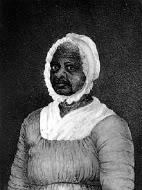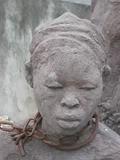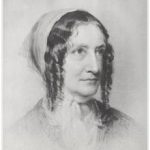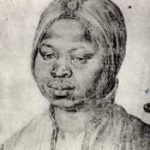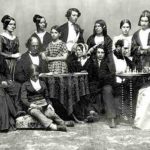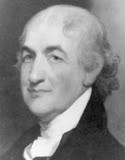Black History Month: Massachusetts Slave
Mum Bett was among the first black slaves in Massachusetts awarded freedom in court under the 1780 constitution, and a decision that slavery was illegal. Her county court case, decided in August 1781, was cited as a precedent in the Massachusetts Supreme Judicial Court appeal review of the Quock Walker case. When the state Supreme Court upheld Walker’s freedom under the constitution, it was considered to have informally ended slavery in Massachusetts.
When Elizabeth Freeman was nearly 70 years old, Susan Ridley Sedgwick painted a miniature portrait of her in watercolor on ivory. Sedgwick was the young wife of Theodore Sedgwick, Jr., whose father had represented Freeman in her claim for freedom from slavery under the Massachusetts Constitution of 1780.
Elizabeth Freeman, known as Bett in early life and later as Mum Bett, was born to enslaved parents in 1742 at the farm of Dutchman Pieter Hogeboom in Claverack, New York, about twenty miles south of Albany. Bett and her younger sister Lizzie grew up as slave children. Freeman was illiterate and left no written records of her life. Her early history has been pieced together from the writings of contemporaries, as well as from historical records.
In 1735 Hogeboom’s youngest child, Hannah, married John Ashley of Sheffield, Massachusetts, the son of one of the original proprietors permitted by the General Court of Massachusetts to organize settlements along the Housatonic River. The Ashleys had four children. Exactly when they acquired Bett and Lizzie is not known, but it was most likely after Hannah’s father died in 1758, when Bett was about sixteen.
John Ashley was a Yale-educated lawyer, wealthy landowner, businessman and leader in the community. In 1761 he was appointed judge of the Court of Common Pleas. His house was the site of many political discussions. In 1773, the town of Sheffield appointed a committee “to take into consideration the grievances which Americans in general and Inhabitants of this Province in particular labor under,” and Ashley was appointed chairman.
The meeting of that committee was held in Ashley’s home in early January 1773 and lasted for several hours. The result was a document called the Sheffield Resolves: a petition against British tyranny and a manifesto for individual rights, drawn up as a series of resolves approved by the town on January 12, 1773. The resolves were written by Theodore Sedgwick and stated that: “Mankind in a State of Nature are equal, free and independent of each other, and have a right to the undisturbed Enjoyment of their lives, their Liberty and Property.”
The Massachusetts Constitution was ratified on June 15, 1780. Mum Bett would have heard it read in the public square. It included the following:
All men are born free and equal, and have certain natural, essential, and unalienable rights; among which may be reckoned the right of enjoying and defending their lives and liberties; that of acquiring, possessing, and protecting property; in fine, that of seeking and obtaining their safety and happiness.
Thus the sentiments expressed by the Sheffield Resolves and the Declaration of Independence were now the law of the state in which Mum Bett lived and worked. Listening to her master’s friends discuss the new Massachusetts Constitution, she concluded that if all people were born free and equal, so was she.
Tradition has it that John Ashley, one of the most prominent and respected men in western Massachusetts, was a relatively humane slave owner. His wife, on the other hand, was described as “a shrew untamable.” Hannah Ashley was raised in the less tolerant Dutch culture of the New York colony.
In a fit of anger one day in 1780, Mrs. Ashley raised a red-hot kitchen shovel to strike Mum Bett’s sister Lizzie. Mum Bett successfully blocked the blow, and received a deep wound in her arm, and remained scarred for life. When Mum Bett left and refused to return, John Ashley went to court to claim his property.
Mum Bett had listened carefully while the wealthy men she served talked about the new state constitution, and she decided that if all people were born free and equal, then she must be, too. When John Ashley appealed to the court for Mum Bett’s return, she went to attorney Theodore Sedgwick to help her sue for her freedom in court.
Sedgwick willingly accepted her case, and enlisted the aid of Tapping Reeve of Litchfield, Connecticut, who later founded America’s first law school. Sedgwick would later say that there was nothing “submissive or subdued” about Mum Bett’s character. But because women had such limited legal rights, the lawyers decided to add another of Ashley’s slaves, a man called Brom, as a party to the suit.
The case was set in motion when Sedgwick obtained a writ of replevin – a form of action taken for the recovery of property – from the Berkshire County Court of Common Pleas. The property in this case was two humans who claimed they were being illegally detained. At least two such writs were sent to John Ashley. After Ashley refused to release the two slaves, the court ordered the sheriff to issue a summons to him to appear at its next session.
The case of Brom and Bett v. Ashley was heard in August 1781 before the County Court of Common Pleas in Great Barrington, Massachusetts. Sedgwick and Reeve asserted that the constitutional provision that “all men are born free and equal” abolished slavery in the state.
The Ashleys were represented by David Noble, who subsequently became a judge, and John Canfield, a respected lawyer from Sharon, Connecticut. They argued that “the said Brom and Bett, are and were at the time of Issuing the original Writ [of replevin], the legal Negro Servants of the said John Ashley during their Lives” and that this could be proved; thus the suit should be dismissed.
Sedgwick and Reeve countered by pleading: “(1) That no antecedent law had established slavery, and that the laws which seemed to suppose it were the offspring of error in the legislators…” and “(2) That such laws, even if they had existed, were annulled by the new Constitution.”
On August 22, 1781, the jury ruled in Freeman’s favor, and she became the first African-American woman to be set free under the Massachusetts Constitution. The jury found that “…Brom & Bett are not, nor were they at the time of the purchase of the original writ the legal Negro of the said John Ashley…” The jury ordered Ashley to pay her damages of thirty shillings and the court costs.
Although a lower court decision with limited influence, it set a precedent for the abolition of slavery in Massachusetts. According to the Massachusetts Judicial Review, the case, often referred to as the Mum Bett or Elizabeth Freeman case, was unique because it occurred less than one year after the adoption of the Massachusetts Constitution and was a direct challenge to the very existence of slavery in the state.
Ashley appealed to the Supreme Judicial Court, but in October, he dropped the appeal. Moreover, “he assented to the lower court ruling that Brom and Bett were not slaves.” In the intervening months, the state’s supreme court had ruled, in another case, that slavery was unconstitutional in Massachusetts. Mum Bett was free.
In arguing a later case Theodore Sedgwick used the example of Freeman when he said in defense of the abolition of slavery, “If there could be a practical refutation of the imagined superiority of our race to hers, the life and character of this woman would afford that refutation.” Sedgwick became a United States Senator and later a justice of the Supreme Judicial Court.
The decision in the Elizabeth Freeman case was cited as precedent when the State Supreme Judicial Court later heard the appeal of Quock Walker v. Jennison. Walker’s freedom was upheld. These cases set the legal precedents that ended slavery in Massachusetts, second only to Vermont.
For the rest of her working life she worked as a paid domestic in the household of Theodore Sedgwick and his second wife Pamela – first in Sheffield and then in Stockbridge, where the family moved in 1785. She served as senior servant and governess to the Sedgwick children, including eldest daughter Catharine Maria Sedgwick, who called her Mum Bett from childhood.
Mum Bett was “the main pillar of the household,” according to Catharine, who became a well-known author. Pamela slipped into severe depression, and Mum Bett was “the only person who could tranquilize my mother when her mind was disordered… She treated her with the same respect she did when she was sane… her superior instincts hit upon the mode of treatment that science has since adopted.”
In the winter of 1785, followers of Shays’ Rebellion broke into the house demanding the family silver, but Mum Bett faced them down. With Theodore Sedgwick away, she had hid the silver in her own chest of drawers; after leading the unruly men from room to room she shamed them out of looking in her chest by urging them to do so. Thus she saved the family silver.
From the time Elizabeth Freeman gained her freedom, she became widely recognized and in demand for her skills as a healer, midwife and nurse.
After the Sedgwick children were grown, Elizabeth Freeman bought a house in Stockbridge – a “little hut,” Catharine Sedgwick called it. Catharine recalled that when she visited Mum Bett there daily during her final illness, “I felt as awed as if I had entered the presence of Washington. Even protracted suffering and mortal sickness… could not break down her spirit.”
On October 18, 1829, Elizabeth Freeman signed – with her mark – her last will and testament. It alone reveals that at some point she was married and had children, grandchildren, and great-grandchildren.
Elizabeth ‘Mum Bett’ Freeman died on December 28, 1829, at 85 years of age.
In the Stockbridge Cemetery there is a plot known as the Sedgwick Pie. In the center of the pie are the tall monuments inscribed with the names of Theodore and Pamela Sedgwick; buried in concentric circles around them are generations of Sedgwicks by birth or marriage, all facing in toward the center so that, it is said, on the Day of Judgment, when the dead shall rise, they shall see no one but other Sedgwicks.
The only person buried there who is not a Sedgwick is Elizabeth Freeman – her tombstone stands in the innermost circle beside the grave of Catharine Sedgwick. She is also the only black among all those whites. The inscription on her tombstone is exceptional too – longer than the others and revealing a personal and profound affection.
It was written by Catharine’s brother Charles and it reads:
ELIZABETH FREEMAN, known by the name of MUMBET died Dec. 28 1829. Her supposed age was 85 years. She was born a slave and remained a slave for nearly thirty years. She could neither read nor write, yet in her own sphere she had no superior nor equal. She neither wasted time nor property. She never violated a trust, nor failed to perform a duty. In every situation of domestic trial, she was the most efficient helper, and the tenderest friend. Good mother fare well.
One of Mum Bett’s great-grandchildren was W.E.B. DuBois, born almost forty years later in Great Barrington, the town where her historic case was argued. In 1895, Du Bois became the first African American to receive a Ph.D. in the subject of history from Harvard University. With the publication of The Philadelphia Negro: A Social Study in 1899, the first case study of a black community in the United States, Du Bois established himself as the first great scholar of black life in America.
My favorite Elizabeth Freeman quote:
Any time, any time while I was a slave, if one minute’s freedom had been offered to me, and I had been told I must die at the end of that minute, I would have taken it. Just to stand one minute on god’s earth a free woman. I would.
SOURCES
Long Road to Justice: Mum Bett
Blackpast.org: Elizabeth Freeman
Wikipedia: Elizabeth Freeman (Mum Bett)
Jury Decides in Favor of Mum Bett Freeman
Africans in America: Elizabeth Freeman (Mum Bett)
American Heritage Magazine: The Slave Who Sued for Freedom
